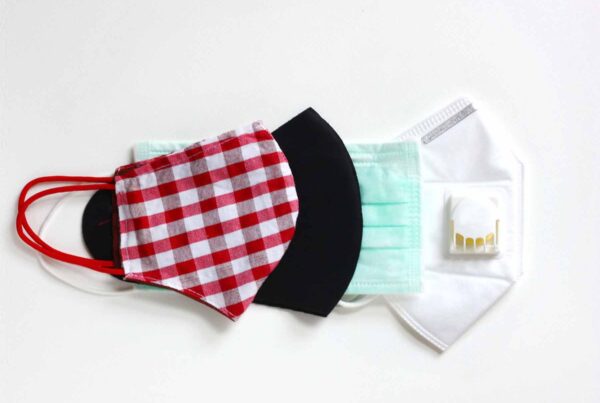Over the course of the pandemic, the marketplace for vetted, medical-grade PPE has been very difficult to navigate, particularly for small and underserved communities with smaller procurement budgets. Counterfeit PPE and price gouging have been rife as demand surged past need, so much so that the Department of Justice announced the formation of a COVID-19 Fraud Task Force in May 2021.

While the Centers for Disease Control and Prevention maintains a website that lists manufacturers who produce FDA- and NIOSH-approved N95s, for the public good, an expanded and frequently updated, user-friendly federally regulated clearinghouse website should be created for all approved, medical-grade PPE to protect frontline and essential workers for future disease threats.
Why We Need a PPE Clearinghouse
Healthcare facilities and many frontline workers continue to request PPE and as late as February 2021 reported reusing PPE due to shortage of supplies. A National Nurses United survey showed that 81% out of 9,200 nurses were reusing single-use PPE. Over a year into the pandemic, healthcare facilities still face shortages of N95 masks and gloves. According to Get Us PPE data, in March 2021, 51% of facilities requesting nitrile gloves and 50% of facilities requesting N95s reported having less than a week’s worth of supply or no supply remaining of each respective type of PPE.
Lack of Transparency
This level of end-to-end transparency is important because the production of specialized PPE such as N95 masks depends on crucial materials the U.S. currently has little capacity to produce. Transparency creates an incentive for manufacturers to build domestic capacity. Ample domestic production capacity for crucial medical supplies such as N95 masks would ensure critical raw materials, human capital, and technical know-how are in place to ramp up production in times of global health emergencies. Better end-to-end transparency of the PPE supply chain will allow governments, health care providers, and the public to assess the weaknesses of the supply chain and push the manufacturers to fix them
Supply-Demand Disconnect
There is also a significant supply chain disconnect within the market. In the first few months of 2021, New York Times reported that the manufacturer DemeTech had 30 million masks in surplus with no buyers, while many facilities were unaware that the masks were available and were reporting supply shortages. Additionally, the National Institute for Occupational Safety and Health (NIOSH) approved almost 20 U.S. manufacturers to make N95 masks, yet has not published any guidance to allocate or dispose of the more than 100 million N95 masks a month going unsold.
Combating Counterfeits
Another issue that has been brought to the forefront during the COVID-19 pandemic is counterfeit equipment. In May 2021, the federal government seized over $3.6 million from MedTech Resource LLC, over the sale of fake N95 masks. Since the pandemic began, US Customs and Border Protection officers have seized about 15 million counterfeit face masks around the country. 1.9 million of the counterfeit masks that were said to have been from “3M” were used in about 40 hospitals in Washington state. These facilities unknowingly distributed fake 3M masks as they were unaware of their source of production and believed the masks were medical-grade, 3M masks.
Kaiser Health News reported in February: “Nurses at Jersey Shore University Medical Center have been highly suspicious since November that the misshapen and odd-smelling ‘3M’ masks they were given are knockoffs, their concerns fueled by mask lot numbers matching those the company listed online as possible fakes.
‘People have been terrified for the last 2½ months,” said Daniel Hayes, a nurse and union vice president at the New Jersey hospital. “They felt like they were taking their lives in their hands, and they don’t have anything else to wear.”’
How a Clearinghouse Can Help
Get Us PPE believes that the government is best suited to provide credible information to healthcare facilities to ensure PPE is adequately distributed. To solve the problems aforementioned, we strongly advocate for a revamped clearinghouse on the CDC website that lists all types of PPE, with frequently updated links to manufacturers that are producing FDA/NIOSH-approved PPE.
Suggested ways to update the clearinghouse:
- Expand the current site list beyond respirators: all types of PPE should be included on the site, including nitrile gloves, surgical masks, and isolation gowns. Currently, there is no updated list of manufacturers of other types of PPE that the public can rely on.
- A more user-friendly site: the site should include the different models available and different model numbers for each type of PPE. A more user-friendly website would make it easier for healthcare facilities to navigate and find PPE based on their needs.
- Update links to sites that manufacture PPE: the site should include a list of links to companies from which facilities can order PPE directly. This would help facilities find and secure PPE faster to restock their equipment.
- Provide more guidance on PPE usage: With so many counterfeits and manufacturers available on the web, the clearinghouse site would be an essential tool to guide facilities on which types of manufacturers to trust, so facilities are getting the best quality of PPE available.
A federally regulated clearinghouse would be lower-cost than combating counterfeits, increase efficiency, and provide a strong, coordinated defense against fraudulent PPE. This clearinghouse would create a transparent PPE marketplace that is equitable and efficient enough to support under-resourced facilities in the country.




